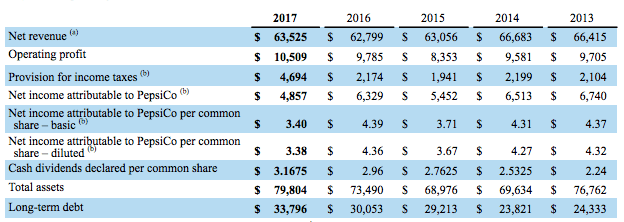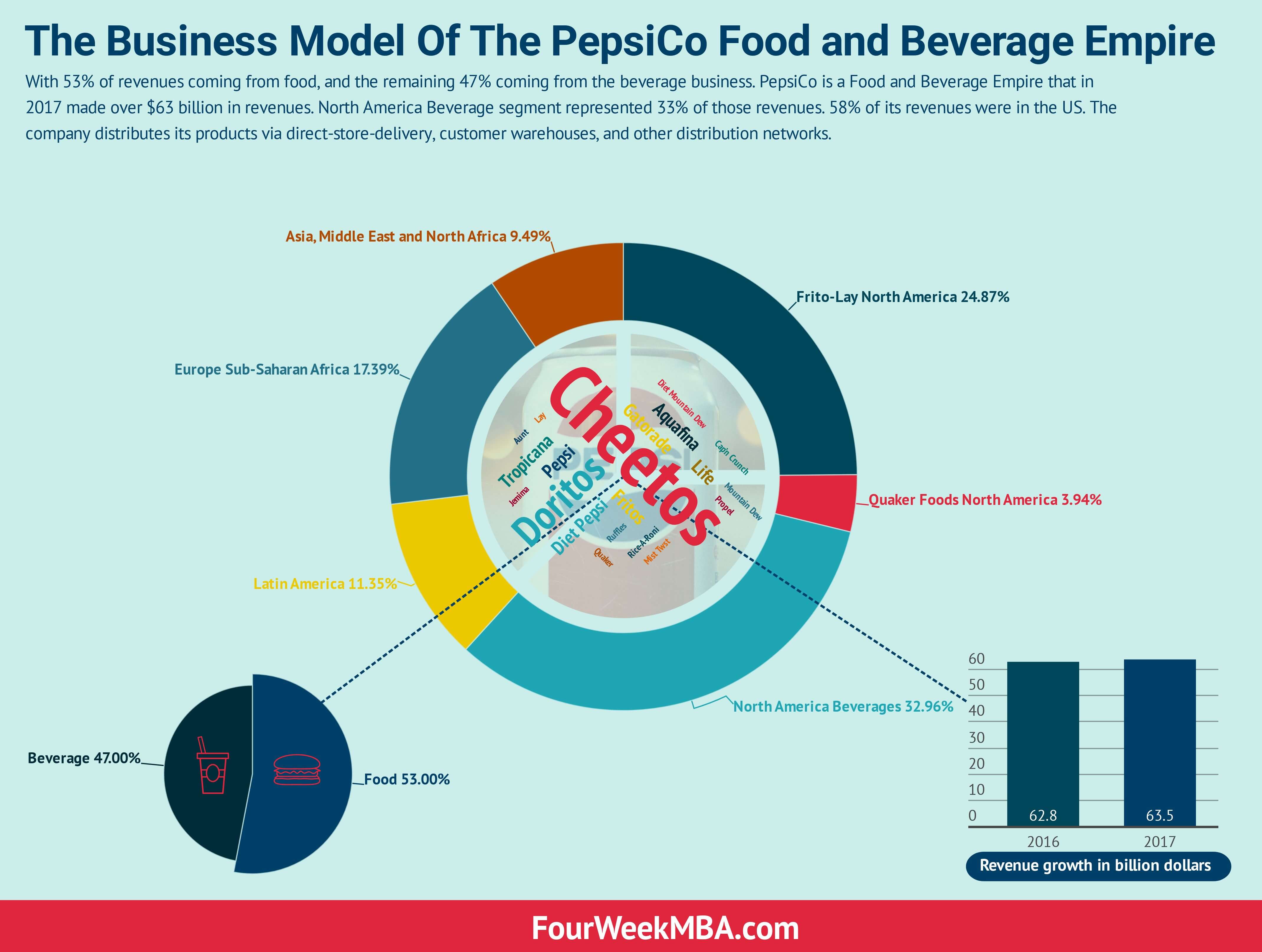| Not logged in : Login |
About: The Business Model Of The PepsiCo Food and Beverage Empire Goto Sponge NotDistinct Permalink

With 53% of revenues coming from food, and the remaining 47% coming from the beverage. PepsiCo is a Food and Beverage Empire that in 2017 made over $63 billion in revenues. North America Beverage segment represented 33% of those revenues. 58% of its revenues were in the US. The company distributes its products via direct-store-delivery, customer warehouses, and other distribution networks. PepsiCo key segments With a multi-billion dollar empire, PepsiCo has refined its business model to make it as agile as possible. With reduced management layers and by leveraging on digitalization the food and beverage empire has managed its logic costs to capture as much growth from the world's market. The company offers a vast range of products in food and beverage. In addition to that PepsiCo, through licensing agreements manufactures and distributes an even broader set of products by organizing joint ventures with other brands. PepsiCo is organized in six main operating segments: Frito-Lay North America (FLNA) (comprising branded food and snack businesses in the United States and Canada): this segment distributes and sells branded snack foods including Cheetos, Doritos, Fritos, Lay, Ruffles Quaker Foods North America (QFNA), includes cereal, rice, pasta and other branded food in the United States and Canada. QFNA makes, markets, distributes and sells cereals, rice, pasta, and other branded products. This segment comprises Aunt Jemima, Cap’n Crunch, Life, Quaker Chewy, Quaker grits, Quaker oat squares, Quaker oatmeal, Quaker rice cakes, Quaker simply granola and Rice-A-Roni side dishes. North America Beverages (NAB) comprises beverage businesses in the United States and Canada such as Aquafina, Diet Mountain Dew, Diet Pepsi, Gatorade, Mist Twst, Mountain Dew, Pepsi, Propel and Tropicana. Other products (such as Lipton from Unilever) are offered via joint ventures. Latin America includes all of the beverage, food and snack businesses in Latin America. This comprises the manufacturing and distribution of Cheetos, Doritos, Emperador, Lay’s, Marias Gamesa, Rosquinhas Mabel, Ruffles, Sabritas, Saladitas and Tostitos, and many Quaker-branded bowls of cereal and snacks. Europe Sub-Saharan Africa (ESSA), which includes all of beverage, food and snack businesses in Europe and Sub-Saharan Africa included in the other segments. Asia, the Middle East and North Africa (AMENA), comprises includes beverages, food and snack businesses in Asia, the Middle East and North Africa. What Is a Business Model? 30 Successful Types of Business Models You Need to Know Distribution strategy of PepsiCo The company distributes its products via three primary channels: direct-store-delivery customer warehouse distributor networks The distribution strategy varies to cover several customer needs, segments, and local business practices. Direct-Store-Delivery It comprises independent bottlers and distributors operating direct-store-delivery systems for beverages, foods, and snacks to retail stores. This distribution strategy works well with products where in-store promotion and merchandising affect their commercial success. Customer Warehouse Other products are delivered to customer warehouses. This system works with products that are less fragile and have a longer life, compared to perishable items. Distributor Networks Through third-party distributors, a wide range of products can have a broader reach on the delivery vehicles. Those distribution networks are particularly effective as they serve restaurants, schools, stadiums and all the places where consumers hang out. Part of this distribution also goes through e-commerce websites. PepsiCo key customers PepsiCo key customers include: wholesale and other distributors foodservice customers grocery stores drugstores convenience stores discount/dollar stores mass merchandisers membership stores hard discounters e-commerce retailers and authorized independent bottlers Who Owns Coca-Cola? Coca-Cola Business Strategy In A Nutshell Marketing campaigns Incentives and discounts through various programs to customers and consumers which comprise sales incentives, rebates, advertising, and other marketing activities played a key role. Advertising and other marketing activities amounted to $4.1 billion. PepsiCo key financial metrics Source: PepsiCo Annual Report 2017 With 53% of revenues coming from food, and the remaining 47% coming from the beverage, PepsiCo is an empire that in 2017 made over $63 billion in revenues. North America Beverage segment represented 33% of those revenues. While 58% of its revenues were in the US. Source: PepsiCo Annual Report 2017 The company also generated over $10.5 billion in 2017, which represented a 16.5% operating margin. Reference for data: PepsiCo Annual Report 2017 Handpicked related articles: What Is a Business Model? 30 Successful Types of Business Models You Need to Know Who Owns Coca-Cola? Coca-Cola Business Strategy In A Nutshell The Power of Google Business Model in a Nutshell How Does Google Make Money? It’s Not Just Advertising! How Does DuckDuckGo Make Money? DuckDuckGo Business Model Explained How Amazon Makes Money: Amazon Business Model in a Nutshell How Does Netflix Make Money? Netflix Business Model Explained
| Attributes | Values |
|---|---|
| type | |
| label |
|
| label |
|
| sameAs | |
| Relation | |
| Description |
|
| depiction | |
| name |
|
| url | |
| legalName |
|
| http://www.w3.org/2007/ont/link#uri |
Alternative Linked Data Documents: PivotViewer | iSPARQL | ODE Content Formats:
![[cxml]](/fct/images/cxml_doc.png)
![[csv]](/fct/images/csv_doc.png) RDF
RDF
![[text]](/fct/images/ntriples_doc.png)
![[turtle]](/fct/images/n3turtle_doc.png)
![[ld+json]](/fct/images/jsonld_doc.png)
![[rdf+json]](/fct/images/json_doc.png)
![[rdf+xml]](/fct/images/xml_doc.png) ODATA
ODATA
![[atom+xml]](/fct/images/atom_doc.png)
![[odata+json]](/fct/images/json_doc.png) Microdata
Microdata
![[microdata+json]](/fct/images/json_doc.png)
![[html]](/fct/images/html_doc.png) About
About


![[RDF Data]](/fct/images/sw-rdf-blue.png)
OpenLink Virtuoso version 08.03.3330 as of Mar 11 2024, on Linux (x86_64-generic-linux-glibc25), Single-Server Edition (7 GB total memory, 5 GB memory in use)
Data on this page belongs to its respective rights holders.
Virtuoso Faceted Browser Copyright © 2009-2024 OpenLink Software





